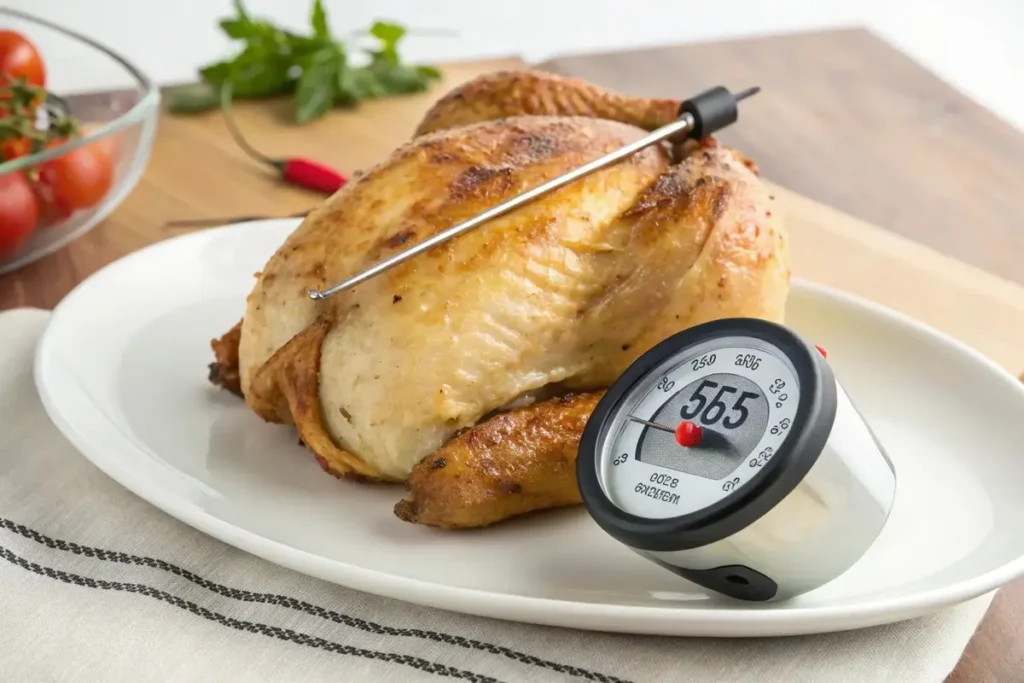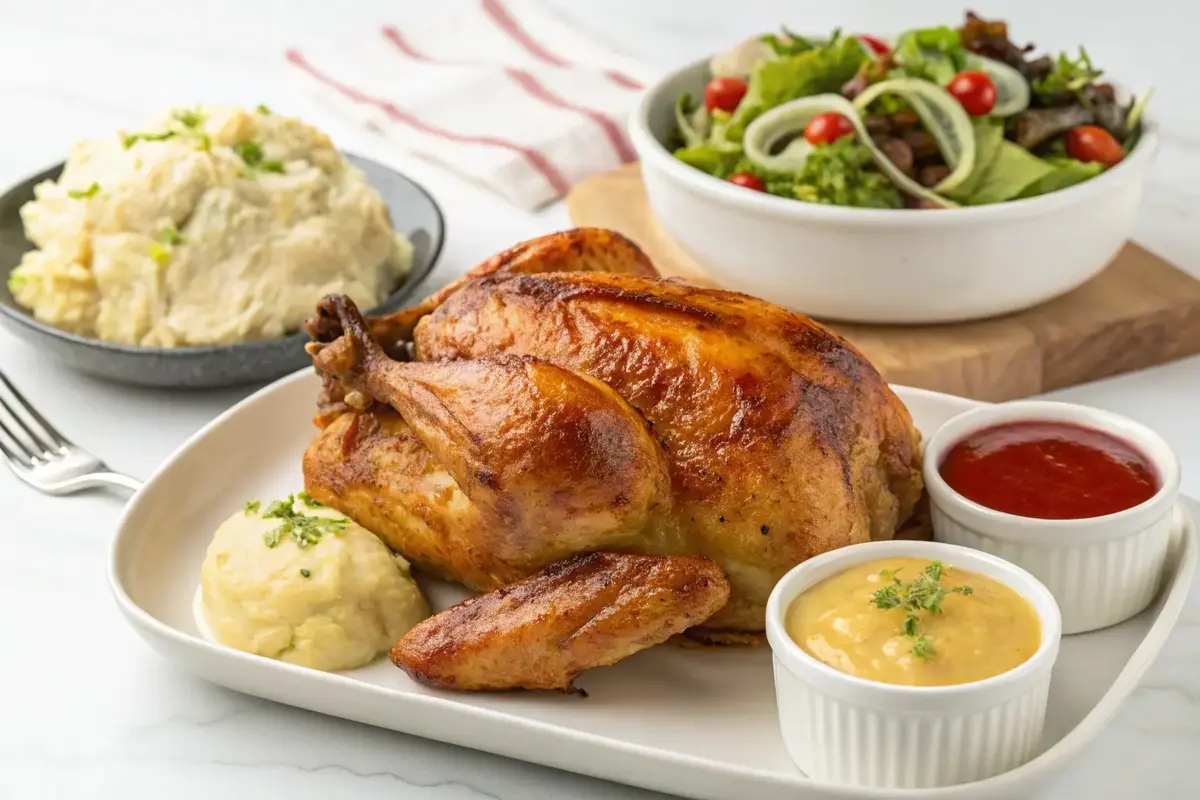Introduction
Eat Rotisserie chicken is a go-to meal for its convenience, flavor, and versatility. But what happens when you have leftovers? Knowing how to enjoy rotisserie chicken the next day ensures you make the most of this delicious dish. Whether you’re reheating, transforming it into new recipes, or storing it safely, this guide covers all you need to know for enjoying rotisserie chicken to the fullest. Let’s dive into the many ways you can make those leftovers a star at your table!
Part 1: Reheating Rotisserie Chicken the Next Day
Best Reheating Methods for Rotisserie Chicken
When it comes to reheating, maintaining moisture and flavor is key. Here are some effective ways:
Using the Oven
The oven is ideal for reheating whole chickens or large portions. Preheat your oven to 375°F and wrap the chicken in foil. Place it on a baking tray and reheat for 20–25 minutes. This method ensures even heating while locking in juices.
Microwave Convenience
For smaller portions, the microwave is a time-saver. Use a microwave-safe dish and cover the chicken with a damp paper towel to prevent drying out. Heat in 1-minute intervals, stirring in between, until it’s warm throughout.
Stovetop Method
Reheating shredded rotisserie chicken? Use the stovetop! Add a splash of broth to a skillet and warm the chicken over medium heat. Stir occasionally to ensure it’s evenly heated.
Tips for Reheating Success
- Add moisture: A sprinkle of water or broth keeps the chicken juicy.
- Monitor temperature: Ensure the internal temperature reaches 165°F for safe consumption.
- Avoid overcooking: Reheating for too long can dry out the meat, so keep a close eye!
Part 2: Proper Storage Tips for Rotisserie Chicken
Storing Rotisserie Chicken Safely
Promptly storing rotisserie chicken after serving is essential for maintaining its flavor and ensuring food safety. Leaving it out too long can invite bacteria growth, so act quickly to preserve its quality.
Refrigeration Tips
Refrigeration is the first step in keeping your chicken fresh. Transfer the chicken into airtight containers or resealable bags to lock in moisture and prevent contamination. Ensure your refrigerator maintains a temperature of 40°F or below, as this is the safe zone to inhibit bacterial growth.
Freezing for Longer Shelf Life
If you won’t consume the leftovers within 3–4 days, freezing is the way to go. Freeze the chicken as soon as possible to retain its quality. For shredded chicken, portion it into meal-sized amounts and store in freezer-safe bags. If keeping it whole, wrap the chicken tightly in plastic wrap and aluminum foil to prevent freezer burn. Frozen chicken can stay good for up to 3 months.
Avoiding Common Storage Mistakes
- Don’t leave it uncovered: Uncovered chicken in the fridge can dry out and absorb unwanted odors.
- Avoid store packaging: The store packaging is not airtight and won’t keep the chicken fresh for long.
- Separate from strong-smelling foods: Keep chicken away from pungent items like onions or garlic to avoid flavor contamination.
By following these storage practices, you can ensure your rotisserie chicken stays fresh, delicious, and safe to enjoy to eat a rotisserie chicken the next day—or even weeks later!
Part 4: Creative Recipes Using Leftover Rotisserie Chicken
Quick and Easy Next-Day Meals
Rotisserie Chicken Sandwiches
To make hearty sandwiches from your leftover rotisserie chicken, start by layering shredded chicken with fresh veggies like lettuce, tomatoes, and cucumbers. Then, add your favorite sauce—whether it’s creamy mayonnaise, tangy mustard, or a bold BBQ sauce. Next, top everything with a slice of cheese for extra flavor. Finally, use toasted bread or a crusty baguette to give your sandwich that satisfying crunch. Not only is this meal simple to prepare, but it’s also perfect for a quick lunch or dinner.
Chicken Tacos
For a fast and flavorful dish, try making chicken tacos with your leftover chicken. Begin by warming up tortillas—flour or corn, depending on your preference. Next, fill them with shredded rotisserie chicken and then layer on salsa, diced onions, cilantro, and a sprinkle of shredded cheese. For a finishing touch, add guacamole or sour cream to give your tacos an authentic, creamy kick. This meal not only saves time, but it also brings a burst of Mexican-inspired flavor to your table.

Chicken Salad
A fresh chicken salad is a quick and versatile option. Combine shredded chicken with a mix of greens, cherry tomatoes, cucumber slices, and your choice of nuts or seeds. Drizzle with a vinaigrette or yogurt-based dressing for a healthy and satisfying meal.
One-Pot Dishes and Casseroles
Chicken Noodle Soup
Leftover chicken is perfect for a comforting bowl of soup. Simmer chicken broth with noodles, diced carrots, celery, and your shredded chicken. Season with garlic, thyme, and a pinch of pepper for a soothing meal that’s easy to make.
Chicken and Rice Bake
Combine shredded chicken with cooked rice, vegetables, and shredded cheese in a casserole dish. Add a creamy sauce or broth, then bake until bubbly and golden. This one-pot wonder is ideal for a hassle-free dinner.
Chicken Stir-Fry
For a quick and flavorful stir-fry, toss leftover chicken with colorful vegetables like bell peppers, snap peas, and carrots in a wok. Add soy sauce, garlic, and ginger for a savory finish. Serve over steamed rice or noodles.
Low-Calorie Options
Lettuce Wraps
For a carb-free option, use large lettuce leaves as wraps. Fill them with shredded chicken, julienned carrots, and cucumber slices. Add a drizzle of peanut or hoisin sauce for a fresh and light meal.
Grain Bowls
Elevate your leftovers with a grain bowl. Start with a base of quinoa or brown rice, add chicken, roasted veggies, and a sprinkle of seeds or nuts. Finish with a light dressing or lemon juice for a nutritious and flavorful dish.
Part 5: Transforming Rotisserie Chicken into Snacks and Appetizers
Easy Snacks and Starters
Chicken Quesadillas
For a quick and satisfying snack, first layer shredded chicken and cheese between two tortillas. Next, cook the quesadilla in a skillet over medium heat until it turns golden brown and crispy. Once done, slice it into triangles and serve with a side of salsa or sour cream for dipping. Not only is this dish simple to prepare, but it also makes a great option for gatherings or solo indulgence.
Chicken Sliders
If you’re looking for a bite-sized treat, start by using small dinner rolls or slider buns to assemble mini sandwiches. Then,add a generous portion of shredded chicken, a slice of cheese, and your favorite condiments to each bun. Finally, secure the sliders with toothpicks for easy handling. Whether served at a party or packed into lunchboxes, these sliders are sure to be a hit with everyone.
Chicken Spring Rolls
Fresh spring rolls offer a healthy and vibrant appetizer option. To begin, lay out rice paper and place shredded chicken, julienned carrots, cucumber, and rice noodles in the center. Carefully, roll the paper tightly to form a neat spring roll. For added flavor, serve the rolls with a side of peanut or soy dipping sauce. This dish not only delights with its visual appealbut also provides a refreshing, Asian-inspired snack.
Part 6: Safety Tips for Leftover Rotisserie Chicken
How Long Can Rotisserie Chicken Be Stored?
Knowing the proper storage time for leftover rotisserie chicken is essential for maintaining its safety and quality. In the refrigerator, cooked chicken can be safely stored for 3 to 4 days at a temperature of 40°F or below. For longer storage, freezing is an excellent option. When properly sealed in airtight containers or freezer bags, chicken can maintain its quality in the freezer for up to 3 months. Label your containers with dates to avoid confusion and to ensure you consume the chicken within its safe window.
Recognizing Spoiled Chicken
Spoiled chicken poses a risk of foodborne illness, so it’s important to recognize the warning signs. Look for discoloration, such as gray or green spots, which indicate bacterial growth. A foul odor, often sour or rancid, is another clear indicator that the chicken has gone bad. Additionally, a slimy or sticky texture on the surface of the meat is a red flag. If you notice any of these signs, discard the chicken immediately to prevent potential health risks.
Avoiding Cross-Contamination
To ensure the safe handling of leftover eat rotisserie chicken, practice proper kitchen hygiene. Always wash your hands with soap and warm water before and after handling chicken to prevent the spread of bacteria. Use separate cutting boards and utensils for raw and cooked foods to reduce the risk of cross-contamination. After preparing meals, thoroughly clean all surfaces and tools that came into contact with the chicken.
When reheating chicken, ensure that the internal temperature reaches 165°F to kill any lingering bacteria. By following these safety tips, you can enjoy your leftover eat rotisserie chicken without worry.

Part 7: Frequently Asked Questions (FAQs)
Can I Eat Rotisserie Chicken Cold the Next Day?
Yes, rotisserie chicken can be eaten cold the next day as long as it has been properly stored in the refrigerator within two hours of purchase. Cold chicken is a versatile option for dishes like salads, sandwiches, or wraps. However, ensure it hasn’t been left at room temperature for too long to avoid bacterial growth.
What’s the Best Way to Reheat Chicken Without Drying It Out?
The key to reheating chicken while keeping it moist is to add a bit of moisture during the process. For example, use a small amount of broth, water, or sauce, and cover the chicken with foil if reheating in the oven.
If you prefer using a microwave, cover the chicken with a damp paper towel to retain moisture and reheat in short intervals, stirring between rounds. This way, you can maintain the chicken’s texture and flavor.
Can I Freeze Rotisserie Chicken After Refrigerating It for a Day?
Absolutely! You can freeze rotisserie chicken even after it has been refrigerated for a day. To ensure the best results, shred or portion the chicken into smaller pieces before freezing.
Store it in airtight containers or freezer bags to maintain freshness. Be sure to consume the frozen chicken within three months for optimal flavor and quality.
Is Reheating Rotisserie Chicken Multiple Times Safe?
While reheating chicken multiple times is technically safe if done correctly, it’s not recommended. Each reheating sessionincreases the risk of bacterial growth and can degrade the chicken’s texture and flavor. To avoid this, reheat only the portion you plan to consume.
How Do I Keep Reheated Chicken Flavorful?
To enhance the flavor of reheated chicken, consider adding seasonings, sauces, or fresh herbs. Additionally, pair it with flavorful sides or use it in recipes like stir-fries or casseroles that allow you to build layers of taste. Adding a little broth or butter during reheating can also bring back its savory appeal.
Part 8: Conclusion
Enjoying Rotisserie Chicken the Next Day
Rotisserie chicken is not only convenient but also incredibly versatile, offering countless ways to transform leftovers into delicious meals.
Proper storage and reheating methods ensure the chicken stays fresh, safe, and flavorful. Whether you enjoy it cold in salads, reheated in casseroles, or repurposed into snacks, the possibilities are endless.
Making the most of leftover rotisserie chicken also helps reduce food waste, saving both time and money. By following the tips and recipes shared here, you can unlock the full potential of this kitchen staple. Get creative, explore new flavors, and enjoy every last bite of your rotisserie chicken leftovers!

